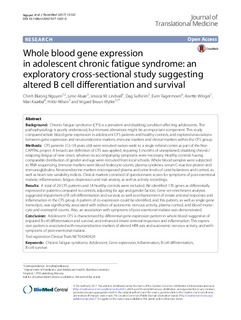| dc.contributor.author | Nguyen, Chinh Bkrong Thi Thuy | |
| dc.contributor.author | Alsøe, Lene | |
| dc.contributor.author | Lindvall, Jessica Margareta | |
| dc.contributor.author | Sulheim, Dag | |
| dc.contributor.author | Fagermoen, Frode Even | |
| dc.contributor.author | Winger, Anette | |
| dc.contributor.author | Kaarbø, Mari | |
| dc.contributor.author | Nilsen, Hilde | |
| dc.contributor.author | Wyller, Vegard Bruun Bratholm | |
| dc.date.accessioned | 2018-05-04T12:35:46Z | |
| dc.date.available | 2018-05-04T12:35:46Z | |
| dc.date.created | 2017-08-30T15:10:16Z | |
| dc.date.issued | 2017 | |
| dc.identifier.citation | Journal of Translational Medicine. 2017, 15:102 1-21. | nb_NO |
| dc.identifier.issn | 1479-5876 | |
| dc.identifier.uri | http://hdl.handle.net/11250/2497211 | |
| dc.description.abstract | Background Chronic fatigue syndrome (CFS) is a prevalent and disabling condition affecting adolescents. The pathophysiology is poorly understood, but immune alterations might be an important component. This study compared whole blood gene expression in adolescent CFS patients and healthy controls, and explored associations between gene expression and neuroendocrine markers, immune markers and clinical markers within the CFS group. Methods CFS patients (12–18 years old) were recruited nation-wide to a single referral center as part of the NorCAPITAL project. A broad case definition of CFS was applied, requiring 3 months of unexplained, disabling chronic/relapsing fatigue of new onset, whereas no accompanying symptoms were necessary. Healthy controls having comparable distribution of gender and age were recruited from local schools. Whole blood samples were subjected to RNA sequencing. Immune markers were blood leukocyte counts, plasma cytokines, serum C-reactive protein and immunoglobulins. Neuroendocrine markers encompassed plasma and urine levels of catecholamines and cortisol, as well as heart rate variability indices. Clinical markers consisted of questionnaire scores for symptoms of post-exertional malaise, inflammation, fatigue, depression and trait anxiety, as well as activity recordings. Results A total of 29 CFS patients and 18 healthy controls were included. We identified 176 genes as differentially expressed in patients compared to controls, adjusting for age and gender factors. Gene set enrichment analyses suggested impairment of B cell differentiation and survival, as well as enhancement of innate antiviral responses and inflammation in the CFS group. A pattern of co-expression could be identified, and this pattern, as well as single gene transcripts, was significantly associated with indices of autonomic nervous activity, plasma cortisol, and blood monocyte and eosinophil counts. Also, an association with symptoms of post-exertional malaise was demonstrated. Conclusion Adolescent CFS is characterized by differential gene expression pattern in whole blood suggestive of impaired B cell differentiation and survival, and enhanced innate antiviral responses and inflammation. This expression pattern is associated with neuroendocrine markers of altered HPA axis and autonomic nervous activity, and with symptoms of post-exertional malaise. | nb_NO |
| dc.language.iso | eng | nb_NO |
| dc.rights | Navngivelse 4.0 Internasjonal | * |
| dc.rights.uri | http://creativecommons.org/licenses/by/4.0/deed.no | * |
| dc.subject | Chronic fatigue syndrome | nb_NO |
| dc.subject | Adolescent | nb_NO |
| dc.subject | Gene expression | nb_NO |
| dc.subject | Inflammation | nb_NO |
| dc.subject | B cell differentiation | nb_NO |
| dc.subject | B cell survival | nb_NO |
| dc.title | Whole blood gene expression in adolescent chronic fatigue syndrome: An exploratory cross-sectional study suggesting altered B cell differentiation and survival | nb_NO |
| dc.type | Journal article | nb_NO |
| dc.type | Peer reviewed | nb_NO |
| dc.description.version | publishedVersion | nb_NO |
| dc.rights.holder | © The Author(s) 2017. This article is distributed under the terms of the Creative Commons Attribution 4.0 International License (http://creativecommons.org/licenses/by/4.0/), which permits unrestricted use, distribution, and reproduction in any medium, provided you give appropriate credit to the original author(s) and the source, provide a link to the Creative Commons license, and indicate if changes were made. The Creative Commons Public Domain Dedication waiver (http://creativecommons.org/ publicdomain/zero/1.0/) applies to the data made available in this article, unless otherwise stated. | nb_NO |
| dc.source.pagenumber | 1-21 | nb_NO |
| dc.source.volume | 15:102 | nb_NO |
| dc.source.journal | Journal of Translational Medicine | nb_NO |
| dc.identifier.doi | 10.1186/s12967-017-1201-0 | |
| dc.identifier.cristin | 1489980 | |
| cristin.unitcode | 1991,6,3,0 | |
| cristin.unitname | Avd Barn | |
| cristin.ispublished | true | |
| cristin.fulltext | original | |
| cristin.qualitycode | 1 | |

